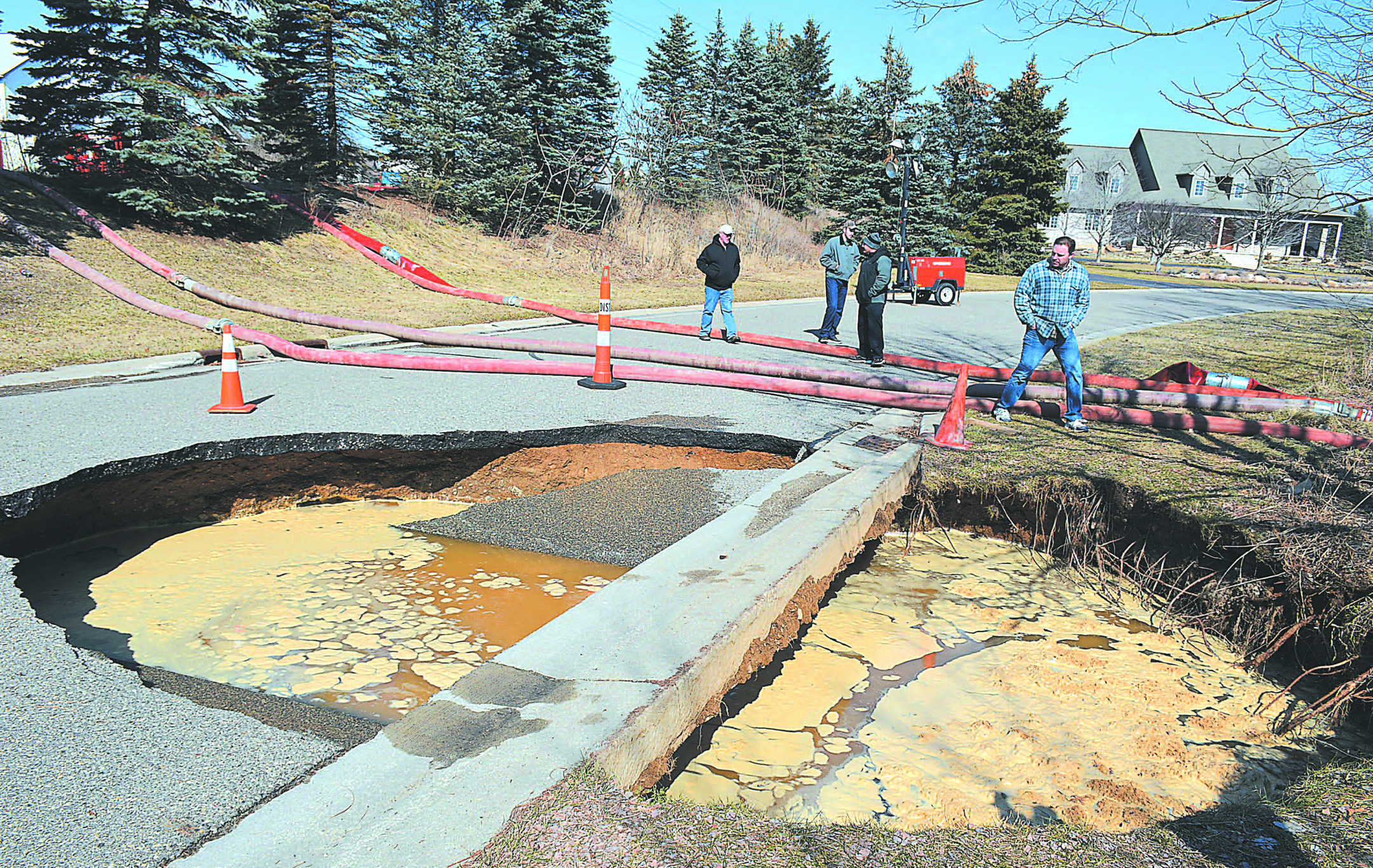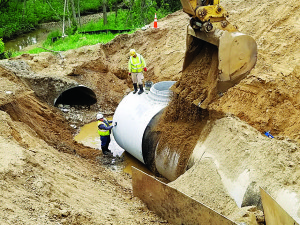
Documents show the Road Commission for Oakland County (RCOC) knew for years that a culvert beneath a subdivision road in Oxford Twp. was steadily deteriorating and had been informed it was on the verge of failing shortly before it did earlier this year.
“A section of the culvert is beginning to collapse,” wrote an inspector on a “request for action” form dated Feb. 15, just nine days before the culvert beneath Wood Trail failed, leading to the formation of a large sinkhole and the collapse of part of the roadway.
On that same form, the inspector, who works for the Lansing-based Great Lakes Engineering Group, LLC, which is under contract with the RCOC, noted the issue “requires immediate action” and recommended “the culvert be programmed for replacement.”
“It was certainly on our radar,” said RCOC Spokesman Craig Bryson. “Our staff was looking at it. They were trying to figure things out. They knew the clock was ticking on this one and they had hoped to do something, actually, this year. Unfortunately, it failed before we were able to do anything about it.”
Safety inspection reports going back three-and-a-half years show the RCOC was aware the condition of a corrugated metal pipe (CMP) that allowed Paint Creek to flow beneath Wood Trail was growing worse and worse.
Words like “heavy rust,” “holes,” “buckling” and “budget for replacement” were repeatedly used year after year in the reports.
These inspection reports were obtained by Oxford Township’s attorney, Gary Rentrop, in late June while he was researching and writing an Aug. 20 opinion letter regarding whether the municipality was financially obligated to share in the cost of the Wood Trail fix (see related story on “Twp. doesn’t owe a dime for culvert project, attorney says”).
Upon reviewing these reports, township Supervisor Bill Dunn wondered why the road commission “didn’t take some proactive approach” to fix the culvert “rather than sitting back and waiting for it to fail.”
“They’ve known it’s been bad for at least three years,” he said. “They should have remedied it. I’m not an engineer, but I think the road commission could have saved themselves a lot of money by fixing the thing when they noticed it was starting to fail.”
“It’s pretty obvious that they should have acted sooner,” Dunn added.
Dunn believes the road commission is lucky no one, be it a motorist or pedestrian, was injured or killed when the road finally gave way on Feb. 25 after the sinkhole became visible the day before.
“It certainly wouldn’t have been the township’s fault,” he said. “We didn’t have any access to any (safety inspection) records. We weren’t notified (about the culvert’s condition). It’s all on the road commission.”

“It wasn’t as though we were ignoring it,” Bryson explained. “We were very aware of it, looking for options, shaking the trees for money.”
Following the failure, it cost $360,000 to replace the CMP culvert with an 84-inch diameter reinforced concrete pipe and rebuild the section of Wood Trail above it.
Wood Trail, south of W. Drahner Rd., between Watersmeet Dr. and Chesnut Ct., was closed from Feb. 24 through Aug. 2. The road leads to and from the Lakes of Indianwood subdivision.
Bryson believes it would have cost about the same amount had the work been done prior the culvert’s failure and sinkhole’s formation. “It seems to me we would have still had to do all the same things,” he said.
Bryson explained “it’s relatively rare that we do a culvert repair.”
“A lot of times, (with) culverts, because of their structure, there isn’t a whole lot of repair you can do,” he said. “Occasionally (they can be repaired), but not very often. Usually, it’s either replace (it) or nothing.”
He noted part of the reason the Wood Trail culvert wasn’t dealt with sooner was because it was a “tricky” fix.
“It was much more than just a simple culvert replacement,” Bryson said. “We couldn’t just . . . .have our crew go in on a weekend, dig it up and put a new one in. It was much more complex than that and therefore, much more expensive.”
The reason it was more complex is because the culvert actually consists of two parts.
The eastern portion, which was made of corrugated metal and ran beneath Wood Trail, was 60 feet long with a diameter of 7 feet. That was the portion that was replaced in early June with the 84-inch diameter reinforced concrete pipe.
However, the western portion, which runs beneath the Polly Ann Trail, consists of a 60-foot long old stone arch that’s still in use.
Designing and tying together the replacement culvert and existing stone arch presented some challenges, according to Bryson.
What the reports had to say
From 2015 through 2017, the culvert’s condition was given a numeric rating of “3” on the annual inspection reports.
According to the legend on the reports, a rating of 3-4 is considered “poor.”
“Heavy rust and scale along length of CMP,” the inspector wrote in the Jan. 28, 2015 report. “Inspector poked holes through both sides of (the) pipe.”
In that same report, the inspector noted there was a 10-inch “deflection” in the pipe “located under (the) roadway.”
A deflection is a sag or a dip.
“In deflected area, corrugations starting to buckle and bottom buckled up,” the inspector wrote.
During the Jan. 6, 2016 inspection, “heavy rust and scale” were again noted and the inspector again “poked holes in both sides of (the) pipe.” However, the deflection increased to 14 inches and the inspector recommended the RCOC “budget for (the pipe’s) replacement.”
The Feb. 22, 2017 report was almost identical to the previous year’s inspection.
Things got worse when the pipe was inspected this year on Feb. 14. The inspector noted there was a 1-foot-by-1-foot “open hole through (the) CMP with (the) loss of backfill along (the) north side.”
He downgraded the culvert’s rating to a “2,” which, according to the report’s legend, means “critical” and the next day, filed paperwork requesting “immediate action.”
Bryson doesn’t want people to think, based on these inspections, the road commission was doing nothing about the culvert.
“Our staff was working hard behind the scenes, trying to figure out A) what to do and B) how to pay for it,” he explained. “We don’t have a big budget for culvert replacement. We also have many culverts across the county that are in bad shape and we prioritize them based on the traffic volumes on the road. (Wood Trail) is a low-volume subdivision road.”
Lots of culverts, not enough money
When asked how many culverts there are in the county, Bryson replied, “We don’t know.”
“There’s a lot that have been there for 50, 60 or more years and there are just not good records of them,” he said. “Frankly, it’s not unusual for us to discover a new one when we go to work on a road.”
“At least 50 (of the culverts the RCOC is aware of) are in critical condition,” said Bryson, and “we’ve got a limited budget” to deal with them.
During the 2018 fiscal year, which ends Sept. 30, the RCOC has spent $402,000 on culvert repairs/replacements as of July 31.
“We had $100,000 budgeted . . . So, (we’re) already four times over budget . . . We’ve replaced a lot this year,” Bryson said.
Bryson explained, “On primary roads, we generally pay the full cost ourselves,” but “on the local roads . . . we ask the community to participate.”
“(With regard to) the $402,000 we’ve spent this year, the vast majority of that has been on primary roads, so we haven’t asked for a contribution (from municipalities),” he said. “There have been a couple – at least one – on subdivision roads where we have asked for a contribution.”
The $360,000 spent on the Wood Trail fix did not come from the culvert budget.
“Because that was a significantly larger, more involved project than most of our typical culvert replacements, we paid for that out of our road construction budget as opposed to our road maintenance budget, which is what the culvert line item is in,” Bryson said.
Next year’s culvert budget, which takes effect Oct. 1, was increased to $150,000, according to Bryson. “Frankly, we don’t have the luxury to go around and proactively repair 50 culverts a year,” he said.
He noted “not all culverts are created equal,” so “there isn’t a set price (where) it’s X (number of) dollars to replace any culvert.”
Costs can vary based on the type and age of the road, the depth of the culvert, the material from which the culvert is made and if there are any requirements from the state Department of Natural Resources to be met.
Given the level of need and the lack of money, culvert replacement is prioritized based on the volume of traffic using the roads.
“If it’s a high-volume road, a culvert failure would have a much greater impact on traffic than on a subdivision street,” Bryson said. “We would be more likely to replace a culvert in slightly better shape on a heavily-traveled road than on a subdivision street simply because of the impact it could have on traffic . . . The busier streets have to be a higher priority.”
Bryson admitted there’s “a little bit more” traffic on Wood Trail than on a “typical” subdivision street because of motorists going through Lakes of Indianwood to travel between W. Drahner and Indianwood roads. “But it’s still a subdivision road . . . and we’ve got plenty of culverts on primary roads that need to be replaced,” he said.
In addition to volume, “the type of traffic” is also a factor. “Generally speaking, a primary road carries more heavy vehicles, (such as) trucks, than a subdivision street,” Bryson said.

Leave a Reply